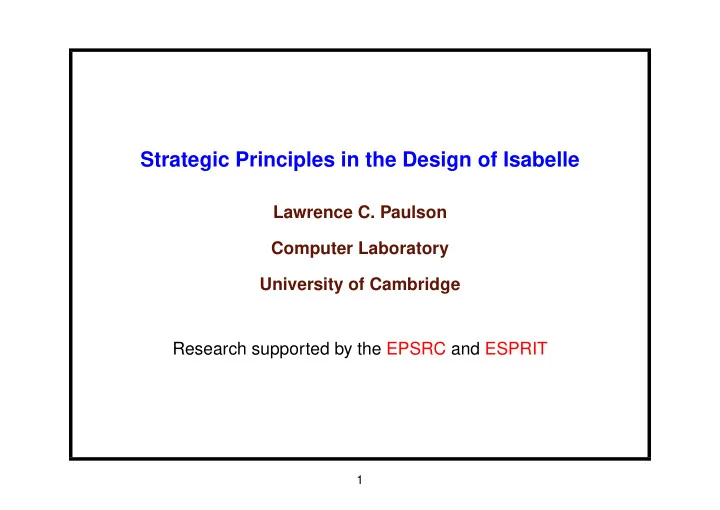

Strategic Principles in the Design of Isabelle Lawrence C. Paulson Computer Laboratory University of Cambridge Research supported by the EPSRC and ESPRIT 1
Proof Assistants: A Strategic View Strength over the long term • automation: essential in an interactive tool • flexibility: for the differing needs of users – control over syntax – a choice of logical formalisms (logical framework!) – a toolkit for proof strategies • soundness needs a small trusted kernel 2
Automation & Flexibility. . . How? • higher-order syntax • logical variables and unification • search primitives based on lazy lists (Can logical frameworks really work?) a sort of higher-order Prolog (like Dale Miller’s λ Prolog) 3
Higher-Order Syntax: A Must! Flexibility: users can define new variable binders � { x ∈ A | P ( x ) } least n. P ( n ) B ( x ) x ∈ A case l of [] ⇒ z | x # l ′ ⇒ f ( x, l ′ ) Doesn’t require higher-order logic Alternatives?? Combinators or auxiliary functions 4
Logical Variables • don’t know subterms can be left unspecified . . . • . . . until unification completes them • helpful for proof procedures • declarative representation of rules rare in higher-order proof tools 5
Declarative Rules Define the quantifier ∀ x ∈ A P ( x ) to be ∀ x [ x ∈ A → P ( x )] Derive the rule ∀ x ∈ A P ( x ) a ∈ A P ( a ) Can be displayed and transformed and combined (resolution!) Alternative representations: code, or higher-order formula 6
Higher-Order + Logical Variables = ? Higher-order unification (Huet, 1975) In the worst case. . . • infinitely many unifiers • semi-decidable • complicated algorithm (Miller’s L λ ) Pattern unification handles the easy cases 7
Tactics Based on Lazy Lists Tactics describe the search space • proof state → list of proof states • result is a lazy list Tacticals explore the search space • tactic → tactic • strategies: depth-first, best-first, iterative deepening, . . . Strategies are easily combined 8
Automation in Predicate Logic Tableaux-style provers for intuitionistic and classical FOL The MESON proof procedure (world’s slowest!) A generic classical reasoner (here, in ZF set theory): � � � C � = ∅ → [ A ( x ) ∩ B ( x )] = ( A ( x )) ∩ ( B ( x )) x ∈ C x ∈ C x ∈ C 1/2 second on Pentium 9
More Automation: Inductive Definitions To formalize • operational semantics: languages, type theories, . . . • proof systems • security Induction rules proved, not assumed Proofs generated using tactics & tacticals Keep the trusted kernel small 10
Some Applications • temporal reasoning: UNITY, TLA, . . . (TUM and Cambridge) • combinations of non-classical logics (MPI-Saarbr¨ ucken) • verification of cryptographic protocols (Cambridge) • Java type safety (TUM) 11
Type Safety? Operational Semantics Operational Semantics Type System Bytecode Verifier Compiler Correctness? BVM Bali Java JVM 12
Bali and BVM Bali: a large subset of Java • class, interface, field & method • inheritance, overriding, & hiding • overloading, dynamic binding, exceptions. . . Bali Virtual Machine • OO concepts (as above) • integers & arrays • predefined exceptions 13
Bytecode Verifier BVM Cornelia Pusch: Isabelle proof of ok ( bytecode ) ⇒ no runtime type error Bali Formalization: 1200 lines 5 weeks Proof of type safety: 2400 lines 10 weeks BVM Formalization BVM: 1100 lines 7 weeks Formalization BV: 600 lines 5 weeks Proof of type safety: 3000 lines 8 weeks 14
Can Cryptography Make Networks Secure? Goals of security protocols: • Authenticity: who sent this message? • Secrecy: who can receive my message? Threats: • Active attacker • Careless & compromised agents . . . NO code-breaking 15
The Needham-Schroeder Protocol (1978) A → B : { Na , A } Kb 1 . Alice sends Bob an encrypted nonce B → A : { Na , Nb } Ka 2 . Bob returns Na with a nonce of his own 3 . A → B : { Nb } Kb Alice returns Bob’s nonce 16
A Middle-Person Attack (1995) Villain Charlie can masquerade as Alice to Bob {A,Na}Kc {A,Na}Kb A C B {Nb}Kc {Nb}Kb Gavin Lowe found this attack 17 years later! 17
Verification Methods • Logics of belief (BAN, 1989) – Allows short, abstract proofs but misses many flaws • State enumeration – Automatically finds attacks but requires strong assumptions • Inductive protocol verification – Trace model of agents – proofs mechanized using Isabelle/HOL 18
Protocol Verification: Results • industrial protocols analyzed (TLS, Kerberos, . . . ) • minutes CPU time, weeks human time per protocol • the power of – inductive definitions – the simplifier – the classical reasoner • substantial proofs found automatically 19
Conclusions • logical frameworks can be practical • lazy lists give the needed flexibility • higher-order syntax can be combined with logical variables • ATP techniques can be used in an interactive tool . . . plus a lot of hard work to make it go! 20
Recommend
More recommend